Yueming Jin
Dynamic Allocation Hypernetwork with Adaptive Model Recalibration for Federated Continual Learning
Mar 25, 2025Abstract:Federated continual learning (FCL) offers an emerging pattern to facilitate the applicability of federated learning (FL) in real-world scenarios, where tasks evolve dynamically and asynchronously across clients, especially in medical scenario. Existing server-side FCL methods in nature domain construct a continually learnable server model by client aggregation on all-involved tasks. However, they are challenged by: (1) Catastrophic forgetting for previously learned tasks, leading to error accumulation in server model, making it difficult to sustain comprehensive knowledge across all tasks. (2) Biased optimization due to asynchronous tasks handled across different clients, leading to the collision of optimization targets of different clients at the same time steps. In this work, we take the first step to propose a novel server-side FCL pattern in medical domain, Dynamic Allocation Hypernetwork with adaptive model recalibration (FedDAH). It is to facilitate collaborative learning under the distinct and dynamic task streams across clients. To alleviate the catastrophic forgetting, we propose a dynamic allocation hypernetwork (DAHyper) where a continually updated hypernetwork is designed to manage the mapping between task identities and their associated model parameters, enabling the dynamic allocation of the model across clients. For the biased optimization, we introduce a novel adaptive model recalibration (AMR) to incorporate the candidate changes of historical models into current server updates, and assign weights to identical tasks across different time steps based on the similarity for continual optimization. Extensive experiments on the AMOS dataset demonstrate the superiority of our FedDAH to other FCL methods on sites with different task streams. The code is available:https://github.com/jinlab-imvr/FedDAH.
SurgRAW: Multi-Agent Workflow with Chain-of-Thought Reasoning for Surgical Intelligence
Mar 13, 2025Abstract:Integration of Vision-Language Models (VLMs) in surgical intelligence is hindered by hallucinations, domain knowledge gaps, and limited understanding of task interdependencies within surgical scenes, undermining clinical reliability. While recent VLMs demonstrate strong general reasoning and thinking capabilities, they still lack the domain expertise and task-awareness required for precise surgical scene interpretation. Although Chain-of-Thought (CoT) can structure reasoning more effectively, current approaches rely on self-generated CoT steps, which often exacerbate inherent domain gaps and hallucinations. To overcome this, we present SurgRAW, a CoT-driven multi-agent framework that delivers transparent, interpretable insights for most tasks in robotic-assisted surgery. By employing specialized CoT prompts across five tasks: instrument recognition, action recognition, action prediction, patient data extraction, and outcome assessment, SurgRAW mitigates hallucinations through structured, domain-aware reasoning. Retrieval-Augmented Generation (RAG) is also integrated to external medical knowledge to bridge domain gaps and improve response reliability. Most importantly, a hierarchical agentic system ensures that CoT-embedded VLM agents collaborate effectively while understanding task interdependencies, with a panel discussion mechanism promotes logical consistency. To evaluate our method, we introduce SurgCoTBench, the first reasoning-based dataset with structured frame-level annotations. With comprehensive experiments, we demonstrate the effectiveness of proposed SurgRAW with 29.32% accuracy improvement over baseline VLMs on 12 robotic procedures, achieving the state-of-the-art performance and advancing explainable, trustworthy, and autonomous surgical assistance.
Instrument-Splatting: Controllable Photorealistic Reconstruction of Surgical Instruments Using Gaussian Splatting
Mar 06, 2025Abstract:Real2Sim is becoming increasingly important with the rapid development of surgical artificial intelligence (AI) and autonomy. In this work, we propose a novel Real2Sim methodology, \textit{Instrument-Splatting}, that leverages 3D Gaussian Splatting to provide fully controllable 3D reconstruction of surgical instruments from monocular surgical videos. To maintain both high visual fidelity and manipulability, we introduce a geometry pre-training to bind Gaussian point clouds on part mesh with accurate geometric priors and define a forward kinematics to control the Gaussians as flexible as real instruments. Afterward, to handle unposed videos, we design a novel instrument pose tracking method leveraging semantics-embedded Gaussians to robustly refine per-frame instrument poses and joint states in a render-and-compare manner, which allows our instrument Gaussian to accurately learn textures and reach photorealistic rendering. We validated our method on 2 publicly released surgical videos and 4 videos collected on ex vivo tissues and green screens. Quantitative and qualitative evaluations demonstrate the effectiveness and superiority of the proposed method.
UnPuzzle: A Unified Framework for Pathology Image Analysis
Mar 05, 2025Abstract:Pathology image analysis plays a pivotal role in medical diagnosis, with deep learning techniques significantly advancing diagnostic accuracy and research. While numerous studies have been conducted to address specific pathological tasks, the lack of standardization in pre-processing methods and model/database architectures complicates fair comparisons across different approaches. This highlights the need for a unified pipeline and comprehensive benchmarks to enable consistent evaluation and accelerate research progress. In this paper, we present UnPuzzle, a novel and unified framework for pathological AI research that covers a broad range of pathology tasks with benchmark results. From high-level to low-level, upstream to downstream tasks, UnPuzzle offers a modular pipeline that encompasses data pre-processing, model composition,taskconfiguration,andexperimentconduction.Specifically, it facilitates efficient benchmarking for both Whole Slide Images (WSIs) and Region of Interest (ROI) tasks. Moreover, the framework supports variouslearningparadigms,includingself-supervisedlearning,multi-task learning,andmulti-modallearning,enablingcomprehensivedevelopment of pathology AI models. Through extensive benchmarking across multiple datasets, we demonstrate the effectiveness of UnPuzzle in streamlining pathology AI research and promoting reproducibility. We envision UnPuzzle as a cornerstone for future advancements in pathology AI, providing a more accessible, transparent, and standardized approach to model evaluation. The UnPuzzle repository is publicly available at https://github.com/Puzzle-AI/UnPuzzle.
PathRWKV: Enabling Whole Slide Prediction with Recurrent-Transformer
Mar 05, 2025


Abstract:Pathological diagnosis plays a critical role in clinical practice, where the whole slide images (WSIs) are widely applied. Through a two-stage paradigm, recent deep learning approaches enhance the WSI analysis with tile-level feature extracting and slide-level feature modeling. Current Transformer models achieved improvement in the efficiency and accuracy to previous multiple instance learning based approaches. However, three core limitations persist, as they do not: (1) robustly address the modeling on variable scales for different slides, (2) effectively balance model complexity and data availability, and (3) balance training efficiency and inference performance. To explicitly address them, we propose a novel model for slide modeling, PathRWKV. Via a recurrent structure, we enable the model for dynamic perceptible tiles in slide-level modeling, which novelly enables the prediction on all tiles in the inference stage. Moreover, we employ linear attention instead of conventional matrix multiplication attention to reduce model complexity and overfitting problem. Lastly, we hinge multi-task learning to enable modeling on versatile tasks simultaneously, improving training efficiency, and asynchronous structure design to draw an effective conclusion on all tiles during inference, enhancing inference performance. Experimental results suggest that PathRWKV outperforms the current state-of-the-art methods in various downstream tasks on multiple datasets. The code and datasets are publicly available.
HC$^3$L-Diff: Hybrid conditional latent diffusion with high frequency enhancement for CBCT-to-CT synthesis
Nov 03, 2024Abstract:Background: Cone-beam computed tomography (CBCT) plays a crucial role in image-guided radiotherapy, but artifacts and noise make them unsuitable for accurate dose calculation. Artificial intelligence methods have shown promise in enhancing CBCT quality to produce synthetic CT (sCT) images. However, existing methods either produce images of suboptimal quality or incur excessive time costs, failing to satisfy clinical practice standards. Methods and materials: We propose a novel hybrid conditional latent diffusion model for efficient and accurate CBCT-to-CT synthesis, named HC$^3$L-Diff. We employ the Unified Feature Encoder (UFE) to compress images into a low-dimensional latent space, thereby optimizing computational efficiency. Beyond the use of CBCT images, we propose integrating its high-frequency knowledge as a hybrid condition to guide the diffusion model in generating sCT images with preserved structural details. This high-frequency information is captured using our designed High-Frequency Extractor (HFE). During inference, we utilize denoising diffusion implicit model to facilitate rapid sampling. We construct a new in-house prostate dataset with paired CBCT and CT to validate the effectiveness of our method. Result: Extensive experimental results demonstrate that our approach outperforms state-of-the-art methods in terms of sCT quality and generation efficiency. Moreover, our medical physicist conducts the dosimetric evaluations to validate the benefit of our method in practical dose calculation, achieving a remarkable 93.8% gamma passing rate with a 2%/2mm criterion, superior to other methods. Conclusion: The proposed HC$^3$L-Diff can efficiently achieve high-quality CBCT-to-CT synthesis in only over 2 mins per patient. Its promising performance in dose calculation shows great potential for enhancing real-world adaptive radiotherapy.
Free-DyGS: Camera-Pose-Free Scene Reconstruction based on Gaussian Splatting for Dynamic Surgical Videos
Sep 02, 2024Abstract:Reconstructing endoscopic videos is crucial for high-fidelity visualization and the efficiency of surgical operations. Despite the importance, existing 3D reconstruction methods encounter several challenges, including stringent demands for accuracy, imprecise camera positioning, intricate dynamic scenes, and the necessity for rapid reconstruction. Addressing these issues, this paper presents the first camera-pose-free scene reconstruction framework, Free-DyGS, tailored for dynamic surgical videos, leveraging 3D Gaussian splatting technology. Our approach employs a frame-by-frame reconstruction strategy and is delineated into four distinct phases: Scene Initialization, Joint Learning, Scene Expansion, and Retrospective Learning. We introduce a Generalizable Gaussians Parameterization module within the Scene Initialization and Expansion phases to proficiently generate Gaussian attributes for each pixel from the RGBD frames. The Joint Learning phase is crafted to concurrently deduce scene deformation and camera pose, facilitated by an innovative flexible deformation module. In the scene expansion stage, the Gaussian points gradually grow as the camera moves. The Retrospective Learning phase is dedicated to enhancing the precision of scene deformation through the reassessment of prior frames. The efficacy of the proposed Free-DyGS is substantiated through experiments on two datasets: the StereoMIS and Hamlyn datasets. The experimental outcomes underscore that Free-DyGS surpasses conventional baseline models in both rendering fidelity and computational efficiency.
Prompt Your Brain: Scaffold Prompt Tuning for Efficient Adaptation of fMRI Pre-trained Model
Aug 20, 2024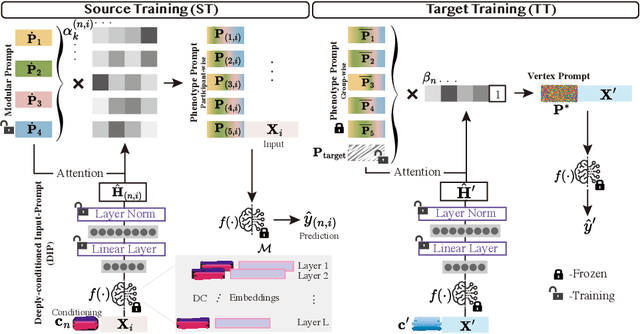
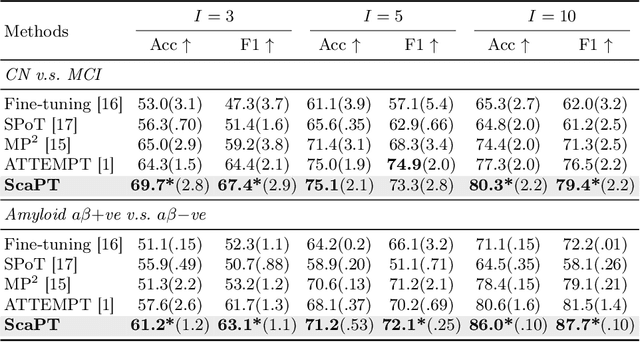

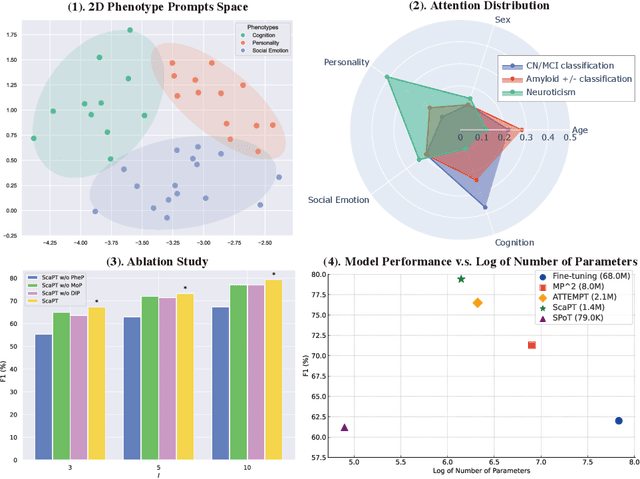
Abstract:We introduce Scaffold Prompt Tuning (ScaPT), a novel prompt-based framework for adapting large-scale functional magnetic resonance imaging (fMRI) pre-trained models to downstream tasks, with high parameter efficiency and improved performance compared to fine-tuning and baselines for prompt tuning. The full fine-tuning updates all pre-trained parameters, which may distort the learned feature space and lead to overfitting with limited training data which is common in fMRI fields. In contrast, we design a hierarchical prompt structure that transfers the knowledge learned from high-resource tasks to low-resource ones. This structure, equipped with a Deeply-conditioned Input-Prompt (DIP) mapping module, allows for efficient adaptation by updating only 2% of the trainable parameters. The framework enhances semantic interpretability through attention mechanisms between inputs and prompts, and it clusters prompts in the latent space in alignment with prior knowledge. Experiments on public resting state fMRI datasets reveal ScaPT outperforms fine-tuning and multitask-based prompt tuning in neurodegenerative diseases diagnosis/prognosis and personality trait prediction, even with fewer than 20 participants. It highlights ScaPT's efficiency in adapting pre-trained fMRI models to low-resource tasks.
Surgical SAM 2: Real-time Segment Anything in Surgical Video by Efficient Frame Pruning
Aug 15, 2024Abstract:Surgical video segmentation is a critical task in computer-assisted surgery and is vital for enhancing surgical quality and patient outcomes. Recently, the Segment Anything Model 2 (SAM2) framework has shown superior advancements in image and video segmentation. However, SAM2 struggles with efficiency due to the high computational demands of processing high-resolution images and complex and long-range temporal dynamics in surgical videos. To address these challenges, we introduce Surgical SAM 2 (SurgSAM-2), an advanced model to utilize SAM2 with an Efficient Frame Pruning (EFP) mechanism, to facilitate real-time surgical video segmentation. The EFP mechanism dynamically manages the memory bank by selectively retaining only the most informative frames, reducing memory usage and computational cost while maintaining high segmentation accuracy. Our extensive experiments demonstrate that SurgSAM-2 significantly improves both efficiency and segmentation accuracy compared to the vanilla SAM2. Remarkably, SurgSAM-2 achieves a 3$\times$ FPS compared with SAM2, while also delivering state-of-the-art performance after fine-tuning with lower-resolution data. These advancements establish SurgSAM-2 as a leading model for surgical video analysis, making real-time surgical video segmentation in resource-constrained environments a feasible reality.
Personalizing Federated Instrument Segmentation with Visual Trait Priors in Robotic Surgery
Aug 06, 2024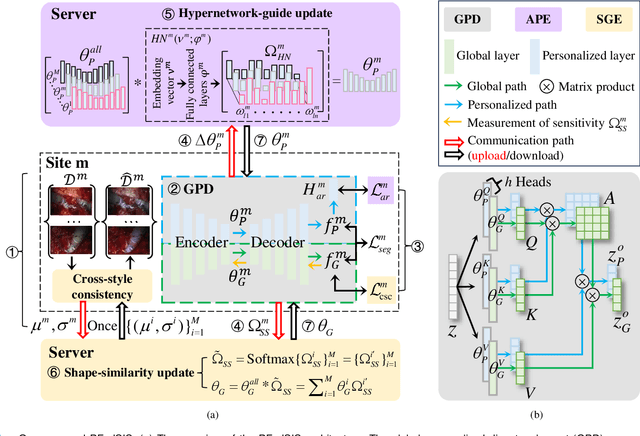
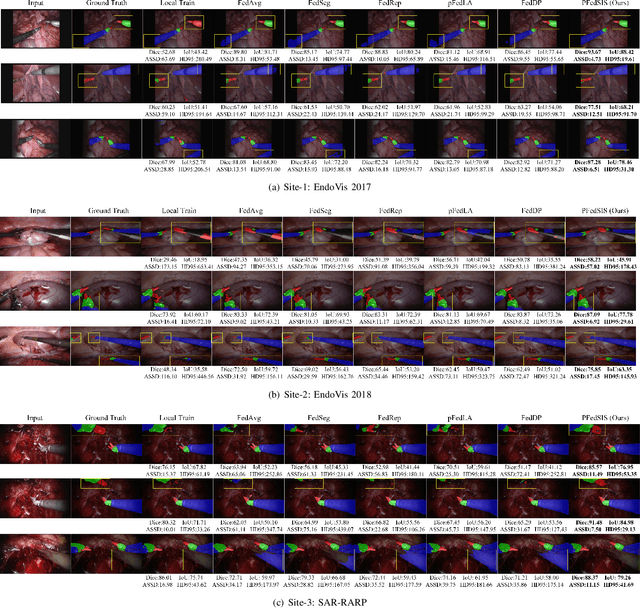
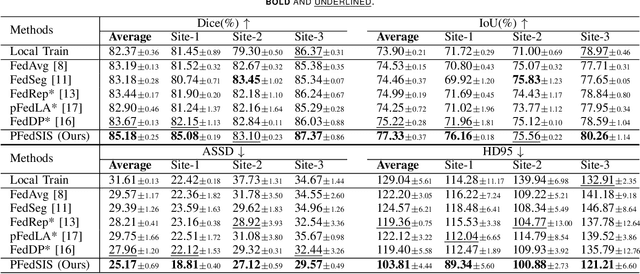

Abstract:Personalized federated learning (PFL) for surgical instrument segmentation (SIS) is a promising approach. It enables multiple clinical sites to collaboratively train a series of models in privacy, with each model tailored to the individual distribution of each site. Existing PFL methods rarely consider the personalization of multi-headed self-attention, and do not account for appearance diversity and instrument shape similarity, both inherent in surgical scenes. We thus propose PFedSIS, a novel PFL method with visual trait priors for SIS, incorporating global-personalized disentanglement (GPD), appearance-regulation personalized enhancement (APE), and shape-similarity global enhancement (SGE), to boost SIS performance in each site. GPD represents the first attempt at head-wise assignment for multi-headed self-attention personalization. To preserve the unique appearance representation of each site and gradually leverage the inter-site difference, APE introduces appearance regulation and provides customized layer-wise aggregation solutions via hypernetworks for each site's personalized parameters. The mutual shape information of instruments is maintained and shared via SGE, which enhances the cross-style shape consistency on the image level and computes the shape-similarity contribution of each site on the prediction level for updating the global parameters. PFedSIS outperforms state-of-the-art methods with +1.51% Dice, +2.11% IoU, -2.79 ASSD, -15.55 HD95 performance gains. The corresponding code and models will be released at https://github.com/wzjialang/PFedSIS.
 Add to Chrome
Add to Chrome Add to Firefox
Add to Firefox Add to Edge
Add to Edge